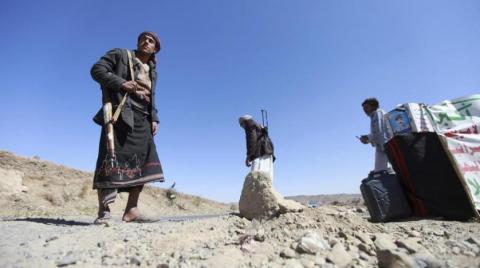Extreme Poverty Threatens Yemenis Living under Houthi Rule


Since the coup by the Iran-align Houthi militias in Yemen in September 2014, 75 percent of the population slid into poverty and 230,000 were killed. The tragedy transformed into the worst humanitarian disaster in the world, according to international reports.
Several recent reports seen by Asharq Al-Awsat revealed the extent of damage to the country’s economy as a result of successive crises caused primarily by the Houthis systematic and repeated targeting of the sector.
A report released and prepared for the UNDP by the Pardee Center for International Futures at the University of Denver revealed the war will triple the number of people living in extreme poverty if the fighting persists. It will skyrocket from 19 percent of the population in 2014 to a projected 65 percent in 2022.
The surge in poverty across Yemen is driven by factors attributed to war, including a breakdown of the economy that has seen USD89 billion in lost economic activity since 2015.
The conflict has disrupted markets and institutions and destroyed social and economic infrastructure. Gross domestic product per capita has plummeted from USD3,577 to USD1,950, a level not seen in Yemen since before 1960.
Yemen is now ranked as the world’s second most unequal in the world in terms of income, surging past 100 other countries in inequality levels in the last five years.
In the absence of conflict, Yemen could have made progress toward achieving the SDGs, the global anti-poverty framework agreed in 2015 with a target date of 2030. But more than four years of fighting has set back human development by 21 years, the report added.
The intensity of poverty has also surged, with Yemen projected by 2022 to have the largest poverty gap—the distance between average income and the poverty line—in the world.
The report identified spikes in malnutrition across the country. Thirty-six percent of the population is malnourished and could reach nearly 50 percent if fighting continues through 2022.
The report contains especially dire projections if the war continues for the next decade. If the fighting continues through 2030, 78 percent of Yemenis will live in extreme poverty, 95 percent will be malnourished and 84 percent of children will be stunted.
Economists told Asharq Al-Awsat that the Houthi coup and looting of public and private facilities was a low point for Yemen.
According to the World Bank, the war waged by the militias led to the destruction of the Yemeni economy.
It is estimated that more than 40 percent of households have lost their primary income source and find it increasingly difficult to purchase the minimum food requirements. Welfare analysis suggests that poverty has increased to an estimated 71 to 78 percent, with women more severely affected than men, the World Bank added.

Sana'a -- A groundbreaking local investigative report has revealed that the Houthi militia in Yemen has been using chemical substances and narcotic…

Al‑Bayda — Human rights sources revealed that Houthi militias have re‑arrested a Yemeni citizen in Al‑Bayda governorate, central Yemen, after…

Sana’a – Medical and human rights circles were shaken by shocking reports confirming that renowned Yemeni orthopedic surgeon Dr. Majid…